
Heidelberg is a city in the German state of Baden-Württemberg, situated on the river Neckar in south-west Germany. As of the 2016 census, its population was 159,914, of which roughly a quarter consisted of students.
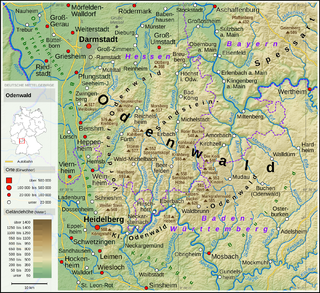
The Odenwald is a low mountain range in the German states of Hesse, Bavaria and Baden-Württemberg.

Heppenheim (Bergstraße) is the seat of Bergstraße district in Hesse, Germany, lying on the Bergstraße on the edge of the Odenwald. It is best known for being the birthplace of Sebastian Vettel, a four-time Formula One World Champion.

Lorsch Abbey, otherwise the Imperial Abbey of Lorsch, is a former Imperial abbey in Lorsch, Germany, about 10 km (6.2 mi) east of Worms. It was one of the most renowned monasteries of the Carolingian Empire. Even in its ruined state, its remains are among the most important pre-Romanesque–Carolingian style buildings in Germany. Its chronicle, entered in the Lorscher Codex compiled in the 1170s, is a fundamental document for early medieval German history. Another famous document from the monastic library is the Codex Aureus of Lorsch. In 1991 the ruined abbey was listed as a UNESCO World Heritage Site because of its architectural and historical importance.

Lorsch is a town in the Bergstraße district in Hessen, Germany, 60 km south of Frankfurt. Lorsch is well known for the Lorsch Abbey, which has been named a World Heritage Site by UNESCO.

Nußloch (help·info) is a municipality in the Rhein-Neckar-Kreis (Baden-Württemberg), about 10 km south of Heidelberg. It is on a much traveled tourist route: Bergstraße and Bertha Benz Memorial Route. The hamlet Maisbach also belongs to Nußloch.

Neuburg Abbey near Heidelberg in Baden-Württemberg is a Benedictine monastery dedicated to Saint Bartholomew, and part of the Beuronese Congregation.

Wettenhausen Abbey was an Imperial Abbey of Augustinian Canons until its secularization in 1802–1803. Being one of the 40-odd self-ruling Imperial Abbeys of the Holy Roman Empire, Wettenhaussen Abbey was a virtually independent state. Its abbot had seat and voice in the Imperial Diet, where he sat on the Bench of the Prelates of Swabia. At the time of secularization, the Abbey's territory covered 56 square kilometers and it had about 5,400 subjects.

Carolingian architecture is the style of north European Pre-Romanesque architecture belonging to the period of the Carolingian Renaissance of the late 8th and 9th centuries, when the Carolingian dynasty dominated west European politics. It was a conscious attempt to emulate Roman architecture and to that end it borrowed heavily from Early Christian and Byzantine architecture, though there are nonetheless innovations of its own, resulting in a unique character.
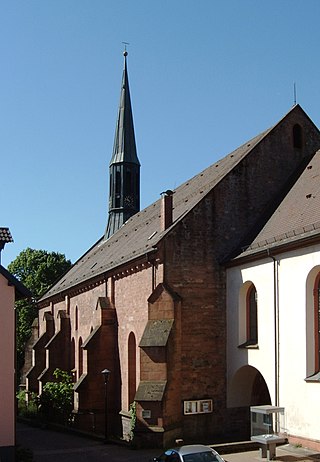
Schönau Abbey in Schönau in the Odenwald, in the Rhein-Neckar-Kreis in Baden-Württemberg, was a Cistercian monastery founded in 1142 from Eberbach Abbey. The present settlement of Schönau grew up round the monastery.
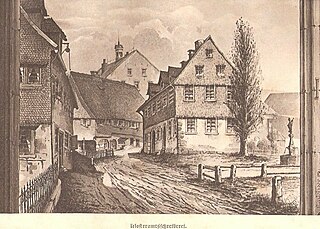
St. George's Abbey in the Black Forest was a Benedictine monastery in St. Georgen im Schwarzwald in the southern Black Forest in Baden-Württemberg, Germany.
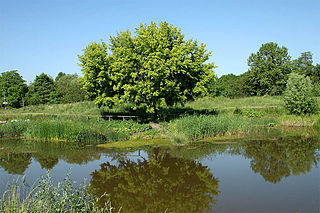
Bürstadt is a town in the Bergstraße district in southern Hesse, Germany, 7 km east of Worms, and 17 km north of Mannheim. In 1981, the town hosted the 21st Hessentag state festival.

Hirschhorn (Neckar) is a small town in the Bergstraße district of Hesse, Germany, and is known as "The Pearl of the Neckar valley”. Hirschhorn is a climatic health resort situated in the Geo-Naturpark Bergstraße-Odenwald.
Innsbruck, an Austrian city, was annexed by Nazi Germany in 1938. It was bombed 22 times by the Allies in World War II, suffering heavy damage.

The Heiligenberg is a large wooded hill overlooking the town of Heidelberg in Baden-Württemberg, Germany. It rises to around 440 metres NHN. It has been the site of many historic and pre-historic constructions, including a Celtic hilltop fortification, a Roman sacred precinct, several medieval monasteries, modern lookout towers and the Heidelberg Thingstätte, built by the Nazis in the 1930s.
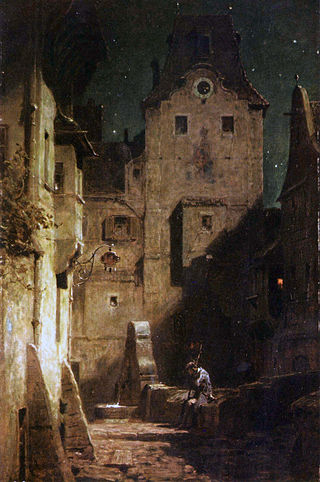
The Kurpfälzisches Museum is a museum of art and archaeology in Heidelberg, Germany. It is located in the Palais Morass. It was founded in the late 1870s, when the city of Heidelberg purchased the private collection of the artist and art historian Charles de Graimberg.

The Hülfensberg is a 448 m high, heavily wooded mountain in the Geismar municipality in the Eichsfeld district, Thuringia, Germany. The mountain has been a pilgrimage site since the late Middle Ages, and on its summit are a church containing a 12th-century crucifix, a Franciscan friary, a chapel dedicated to Saint Boniface, and a large free-standing cross.

Heiligenberg Castle is a princely castle in renaissance style, situated in Heiligenberg, Linzgau within the state of Baden-Württemberg, Germany. It is sited on a plateau 730 metres above sea level and with views down into the Bodensee and the Alps. It contains one of the most well preserved renaissance halls north of the Alps. The castle is owned and lived in by the Fürstenberg family, and cannot be visited.

The Heidelberg Thingstätte is an open-air theatre on the Heiligenberg in Heidelberg, Baden-Württemberg, Germany. It was built during the Third Reich for performances and events as part of the Thingspiel movement. Until 2018, it was primarily used for unofficial Walpurgis Night celebrations. It is a protected cultural monument.

The Old University is an important baroque building of the University of Heidelberg located between the Hauptstrasse and the Universitätsplatz in the old town of Heidelberg. It contains the Hall of the University, once the main assembly hall and lecture theatre of the University, as well as the Heidelberg University Museum and the old University gaol.






















